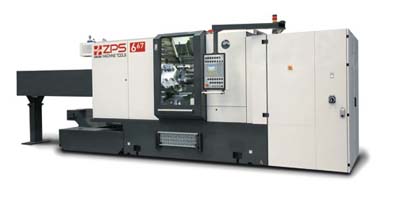667 6-Spindle Automatic Lathe
667 6-Spindle Automatic Lathe
ZPS America LLC announces its newest cam-driven 6-spindle automatic lathe with 51 to 67mm bar capacity.

ZPS America LLC announces its newest cam-driven 6-spindle automatic lathe with 51 to 67mm bar capacity. The rigid, European-built machine is designed for continuous or series production of precision turned parts. Solid base casting ensures maximum rigidity and stability.
The machine includes six frontal slides with up to 142 working strokes, and six cross slides plus four compound slides with clamping, and bar stop in the 6th station. An independent cam controls each slide. Stroke is adjustable on the rocker arm of the corresponding drive. The 667 machines are provided with different spindle speed ranges (200 to 3200 rpm), depending on material type and size.
Through the Hirth coupling with the spindle drum being fine bored in the casting positioning errors are eliminated. The maltese cross smoothes precise indexing to increases the accuracy and longevity of the machine tool. Another new development by ZPS. The ZPS machines are designed for precision, safety, and long, reliable operation. Four safety clutches prevent the slides from overloading.
Spindle drum locking is accomplished by a Hirth coupling for ultimate concentricity, repeatability and precision. A bar stock guide is standard, and the machine can also include automatic bar loaders and bar magazines for long, unattended operation.
Spindles are driven by Siemens variable speed motors and the machines are controlled through a SIMATIC S7-300. To accomplish nearly any operation, the machines can be provided with a wide range of optional equipment, including NC drive of the pick-up spindle, bar stock feeding and clamping in the third station, attachments for high-speed drilling, reaming, tapping and broaching, and multi-spindle drilling heads on the frontal slides.
"Because ZPS America is the factory, we can help you upgrade your cam machines with CNC slides and Siemens controls, and even help evaluate whether to exchange your ZPS cam machine for one of our CNC multis," said Olaf Tessarzyk, Managing Partner and President of ZPS America. "To help customers maintain trouble-free performance, we also offer full preventative maintenance plans for each of our machines. Prompt factory service from local resident service and applications engineers that have worked multiple years at the factory and prompt factory warranted spare parts are very important to multispindle users."





